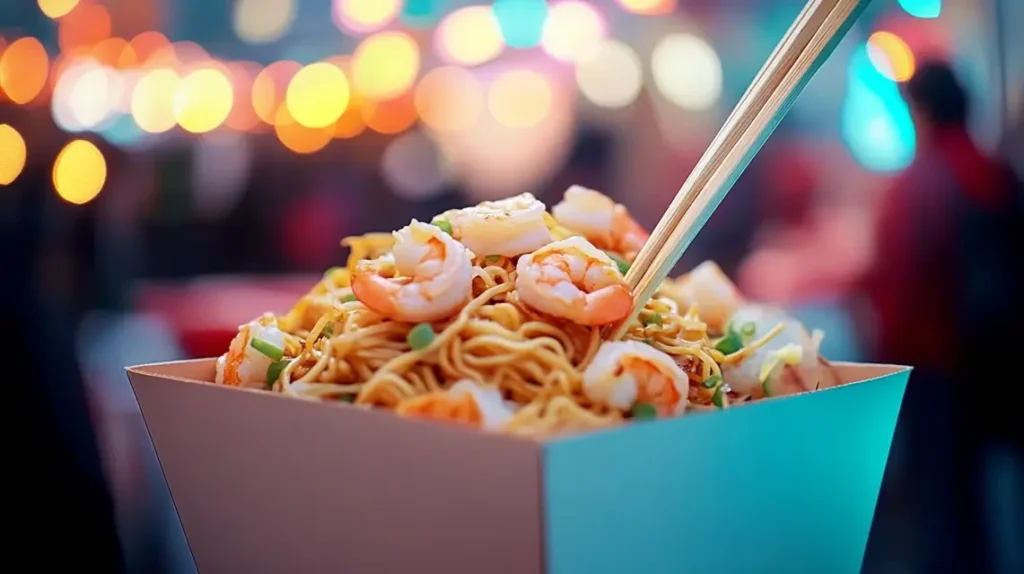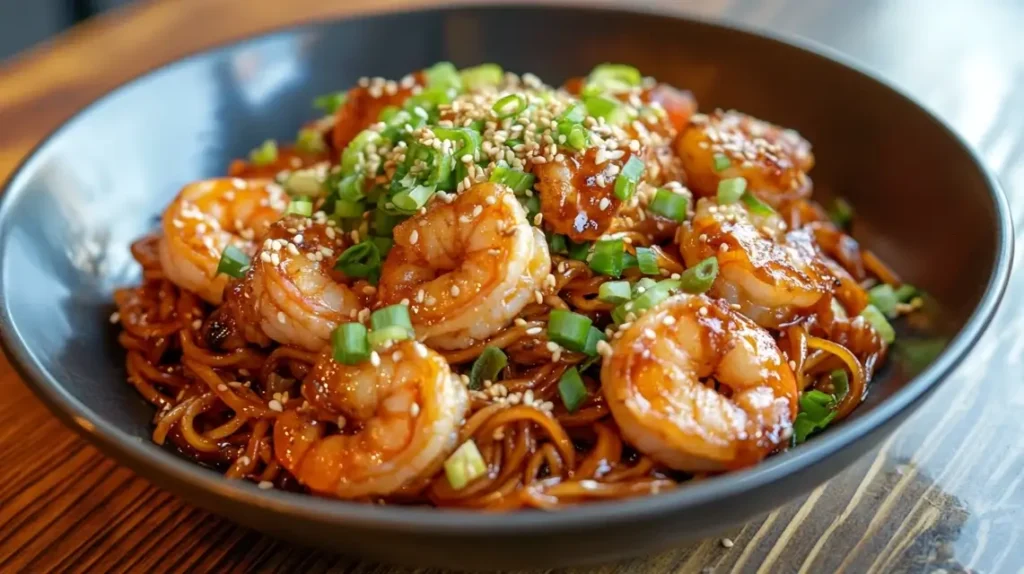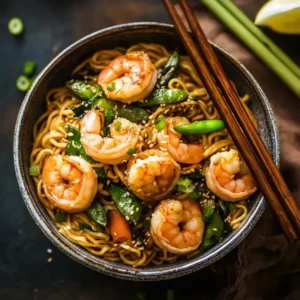Japanese Shrimp Yakisoba is a fun and flavorful noodle dish that’s loved for its quick cooking time, colorful veggies, juicy shrimp, and savory-sweet sauce. It’s one of those meals that looks fancy but is actually super easy to make at home.
In this article, you’ll learn everything about Japanese Shrimp Yakisoba: from what it is, what ingredients to use, how to cook it step-by-step, to the best tips and tasty swaps. You’ll also find out how to serve it, what to eat with it, and how to store leftovers. Whether you’re a kid in the kitchen or just someone who loves noodles, you’ll find this guide easy to follow and totally delicious.
Let’s jump in!
What is Japanese Shrimp Yakisoba?
What Does “Yakisoba” Mean in Japanese Cooking?

“Yakisoba is one of Japan’s favorite street dishes, served hot and full of flavor.”
Yakisoba (焼きそば) literally means “fried noodles” in Japanese. Even though it sounds like soba, it’s actually made with wheat-based noodles, not buckwheat. These noodles are stir-fried in a hot pan or wok with veggies, meat, or seafood like shrimp!
“Yakisoba is one of Japan’s favorite street foods, often found sizzling on open grills at festivals or markets.”
When you add shrimp, it becomes a seafood yakisoba rich, meaty, and packed with ocean flavor. The shrimp is usually sautéed until pink and tender, then mixed with noodles and veggies like cabbage and carrots.
How Shrimp Turns Yakisoba Into a Seafood Favorite
Shrimp brings a juicy bite and sweet, briny flavor to this noodle dish. It pairs perfectly with the tangy-salty sauce made from soy sauce, Worcestershire, and oyster sauce. Together, they create that bold taste Japanese Shrimp Yakisoba is known for.
Plus, shrimp cooks super fast, making this recipe perfect for busy weeknights. Whether you use fresh or frozen shrimp, the result is always tasty and satisfying.
Here’s a quick look at what makes this dish so special:
| Why People Love Shrimp Yakisoba |
|---|
| Ready in under 30 minutes |
| Uses simple ingredients |
| Easy to customize |
| Full of flavor and texture |
| Great as a meal or side dish |
And of course, it’s fun to eat with chopsticks!
Great! Based on the sitemap analysis, I’ll add a relevant internal link from Yuum Recipes in this section, since it aligns with the seafood/shrimp theme.
Ingredients You’ll Need for Shrimp Yakisoba
Fresh vs. Frozen Shrimp – What Works Best?
Whether you’re team fresh or frozen, both shrimp types can work wonders in Japanese Shrimp Yakisoba. Fresh shrimp brings a tender texture and cleaner flavor, but don’t worry frozen shrimp can be just as good if you thaw it right.
If using frozen, pat it dry after defrosting so it sears nicely in the pan. You’ll want jumbo or large shrimp for a meatier bite that stands out against the noodles.
“Fresh shrimp adds depth, but frozen shrimp adds convenience either way, you win.”
Types of Noodles Used in Yakisoba
Now let’s talk noodles. Traditional yakisoba noodles are wheat-based and come pre-cooked in vacuum packs. But don’t sweat it if you can’t find them. Here are great alternatives:
- Ramen noodles (without the seasoning packet)
- Udon noodles
- Even spaghetti (if you’re in a pinch)
Make sure to cook or rinse them briefly before stir-frying.
Vegetables and Sauces That Add Flavor
The veggies are where the fun begins! Crunchy carrots, sweet cabbage, and sliced onions bring color and texture. Don’t forget toppings like green onions and pickled ginger they make everything pop!
As for the sauce? Oh boy it’s where the magic lives. A mix of soy sauce, oyster sauce, Worcestershire sauce, and fresh ginger makes it tangy, salty, sweet, and just a little spicy.
Here’s a quick ingredient table to keep things simple:
| Ingredient | Quantity | Notes |
|---|---|---|
| Shrimp (peeled & deveined) | 1 lb | Large or extra-large for best texture |
| Yakisoba noodles | 16 oz (or 8 oz dry) | Rinse or boil dry noodles |
| Carrots (shredded) | 2 cups | Julienned for texture |
| Cabbage (shredded) | 3 cups | Green cabbage works best |
| Yellow onion (sliced) | ½ large | Adds sweetness |
| Green onion (chopped) | 2 stalks | For garnish |
| Pickled ginger | As needed | Optional but tasty |
| Soy sauce | 3 tbsp | Use full-sodium for flavor |
| Oyster sauce | 1 tbsp | Brings sweetness |
| Worcestershire sauce | 1 tbsp | Adds tang |
| Fresh ginger (grated) | 2 tsp | Can use dry in a pinch |
| Red pepper flakes | A pinch | Optional heat |
| Cooking oil | 3 tbsp | Avocado or canola recommended |
Japanese Shrimp Yakisoba is flexible feel free to sub in bell peppers, mushrooms, or even snap peas. You can even pair it with something like Mexican shrimp fajitas for a double shrimp delight!
How to Cook Japanese Shrimp Yakisoba at Home
Step-by-Step Instructions – Stir-Fry Made Simple
Cooking Japanese Shrimp Yakisoba is easier than tying your shoes (well, almost). Here’s a step-by-step method that’ll get you to noodle bliss in under 30 minutes:
“Hot pan, bold sauce, and fast hands. That’s the yakisoba way.”
How to make it:
- Whisk the sauce
In a bowl, mix soy sauce, oyster sauce, Worcestershire sauce, ginger, and red pepper flakes. Set it aside. - Cook the shrimp
Heat a tablespoon of oil in a large pan. Sauté shrimp for 2–3 minutes per side until pink. Remove and set aside. - Sauté the veggies
In the same pan, add more oil and cook onions, carrots, and cabbage for about 5 minutes. You want them soft but still crisp. - Toss noodles and sauce
Add the noodles and pour in your sauce. Stir everything together so the flavor coats every bit. - Combine and serve
Return shrimp to the pan, mix it all, and garnish with green onions and pickled ginger. Boom. Done.
Cooking Shrimp Just Right – Not Too Soft or Chewy
Shrimp cooks fast like really fast. If you overdo it, you’ll get tough, rubbery bites, and nobody wants that.
Here’s a good rule of thumb:
As soon as your shrimp turns pink and opaque, it’s done. Get it out of the pan so it doesn’t keep cooking from the heat.
“Overcooked shrimp is like chewing a rubber band. Be quick, be gentle, be awesome.”
You can also grill the shrimp separately or even try air frying for a crispy twist.
Easy Swaps and Creative Add-ins
Substitute Ideas for Vegetables or Sauces
One of the best things about Japanese Shrimp Yakisoba is how easy it is to make it your own. Don’t have cabbage or carrots? No problem! There are plenty of tasty swaps that still keep the dish delicious.
Here are some smart switches:
| Instead of this… | Try this instead |
|---|---|
| Green cabbage | Bok choy or napa cabbage |
| Carrots | Bell peppers or zucchini |
| Yellow onion | Green onion or leeks |
| Oyster sauce | Hoisin sauce + fish sauce |
| Soy sauce | Tamari or coconut aminos |
Want to kick it up? Try adding:
- Snap peas for crunch
- Mushrooms for a savory bite
- Pineapple chunks for a sweet twist
You can even turn it into a spicy yakisoba by adding chili garlic sauce or sriracha.
“Yakisoba isn’t just a recipe it’s a playground. Mix it, match it, make it your own.”
Don’t worry if you’re missing one thing or two. As long as you’ve got noodles, shrimp, and some bold sauce, you’re on your way to a flavorful plate.
For more delicious recipe ideas, check out other popular dishes on Yuum Recipes. You might discover a new favorite side dish or sauce idea!
Making a Vegetarian or Gluten-Free Version
Got dietary needs? We’ve got you covered.
Vegetarian Yakisoba:
- Swap shrimp with tofu or tempeh
- Use vegetable-based sauces without oyster or fish sauce
- Load up on veggies like mushrooms, bell peppers, and kale
Gluten-Free Yakisoba:
- Use rice noodles or certified gluten-free yakisoba noodles
- Swap soy sauce for tamari
- Double-check that your sauces (like Worcestershire) are gluten-free
Making these changes still gives you that rich flavor without the worry. You’re not missing out you’re leveling up!
Expert Tips for Better Yakisoba
What to Watch Out For When Cooking Shrimp
Cooking shrimp for Japanese Shrimp Yakisoba is a bit of an art. It’s fast, but that also means it’s easy to mess up if you’re not watching closely.
Here’s what you should keep an eye on:
- Color change: Shrimp turns pink when done don’t wait longer.
- Curl test: Perfectly cooked shrimp makes a “C” shape. If it curls into an “O”, it’s overcooked.
- Don’t crowd the pan: Cook in batches if needed to keep that sizzle.
“Shrimp is like a toddler it needs attention or things get messy fast.”
Also, season shrimp lightly before cooking. A little salt, garlic powder, or even lemon zest makes a big difference.
How to Keep Noodles from Getting Mushy
Nobody likes soggy noodles. That’s why getting the texture just right in your yakisoba is super important.
Here’s how to keep those noodles springy and perfect:
- If using pre-cooked noodles: Just rinse in warm water and pat dry.
- If using dried noodles: Cook slightly under what the package says.
- Avoid soaking in sauce: Toss everything quickly and remove from heat.
Use high heat when stir-frying, and don’t let your noodles sit in the pan for too long. Quick toss, then out they’ll thank you with that perfect chew.
“Hot pan, fast hands, and a quick flip that’s the secret noodle handshake.”
Following these small tips can make your Japanese Shrimp Yakisoba taste just like it came from a Tokyo street cart!
Serving and Storing Japanese Shrimp Yakisoba
Best Ways to Serve This Noodle Stir-Fry

“Serve your shrimp yakisoba hot, topped with ginger, green onions, and a sprinkle of sesame seeds.”
When your Japanese Shrimp Yakisoba is hot and ready, you’ll want to serve it in a way that shows off all that colorful goodness. A shallow bowl or wide-rimmed plate works great. That way, the shrimp, veggies, and noodles can shine without piling on top of each other.
Here are some fun serving tips:
- Sprinkle chopped green onions or sesame seeds on top
- Add a little pickled ginger for a pop of color and tang
- Serve with chopsticks for a real Japanese feel (but a fork works too!)
“The secret to serving yakisoba isn’t just taste it’s the look, the aroma, and that first steamy bite.”
You can also serve this dish with a small bowl of soup or a crisp salad on the side. It’s perfect for lunch, dinner, or even a fun weekend dinner party.
How to Store and Reheat for Another Meal
Got leftovers? No worries Japanese Shrimp Yakisoba keeps well if you store it right.
Here’s how to do it:
- Let the noodles cool completely before storing
- Place them in an airtight container
- Store in the fridge for up to 2 days (since it has shrimp)
When reheating, use a microwave or heat it gently in a pan with a splash of water. This helps bring the noodles back to life without drying them out.
“Leftover yakisoba is just as good the next day maybe even better!”
Avoid freezing this dish. The noodles can get mushy and the shrimp may lose its texture. Fresh is best, and next-day is still yum!
What to Eat With Shrimp Yakisoba
Side Dishes That Go Great With Yakisoba
While Japanese Shrimp Yakisoba is filling on its own, it gets even better with the right side dish. Adding a simple appetizer or snack can turn this meal into a full-blown feast.
Here are some tasty options:
- Gyoza (Japanese dumplings) – pan-fried and crispy
- Miso soup – warm, comforting, and light
- Seaweed salad – crunchy and slightly salty
- Edamame – steamed soybeans sprinkled with sea salt
- Spring rolls – for a crispy crunch with a sweet dip
You could even toss in some pickled veggies or a few slices of Japanese cucumber salad for extra balance. The key is to keep the sides light and tasty, so they match the bold flavors of your shrimp yakisoba.
Sauces, Garnishes, and Drinks to Pair
Let’s not forget the little extras! They can really bring your meal to life.
Toppings and garnishes:
- Pickled ginger
- Roasted sesame seeds
- Nori (seaweed strips)
- A drizzle of sriracha or spicy mayo
Drink ideas:
- Iced green tea for a cool, refreshing sip
- Sparkling water with lemon
- Japanese soda like Ramune for a fun treat
“Great food needs great company and just a splash of sauce.”
When in doubt, keep things simple. You don’t need anything fancy just good flavors that let your Japanese Shrimp Yakisoba shine.
Common Mistakes to Avoid
Using the Wrong Type of Noodles
One mistake people often make when trying to cook Japanese Shrimp Yakisoba is using the wrong kind of noodles. While the word “soba” might sound like buckwheat noodles, yakisoba actually uses wheat noodles. If you use soba or spaghetti straight from the box without boiling or rinsing, you’ll likely end up with a sticky mess.
So, what should you do instead?
- Look for fresh yakisoba noodles in the refrigerated section
- If using dried noodles, cook them until just tender, then rinse
- Avoid overcooking mushy noodles ruin the fun!
“Right noodles make all the difference. Choose wisely, and your yakisoba will be restaurant-worthy!”
Overcooking or Underseasoning the Shrimp
Shrimp is quick to cook, but that’s also what makes it tricky. Overcooked shrimp gets rubbery fast, and undercooked shrimp just feels… weird. Neither is tasty.
Here’s what you can do to get it right:
- Shrimp should cook until it’s pink and C-shaped
- Don’t walk away from the pan it only takes 2–3 minutes
- Season the shrimp before cooking to bring out the flavor
And don’t forget the sauce! If your yakisoba tastes too plain, it probably needs more of that soy, oyster, and Worcestershire mix. Just go slow you can always add more, but you can’t take it out once it’s in.
Fun Facts and History of Yakisoba in Japan
Where Yakisoba Came From
Yakisoba has been a popular street food in Japan for nearly 100 years. It first showed up around the 1930s and quickly became a festival favorite. Even though “soba” means buckwheat, yakisoba noodles are actually made from wheat flour more like ramen noodles than soba!
It’s often cooked on big flat grills at food stalls, where people can smell the delicious mix of noodles, meat, and sauce from far away. And guess what? It’s super popular with kids and grown-ups alike.
“In Japan, yakisoba is more than food it’s part of family fun, festivals, and happy memories.”
Why Shrimp Yakisoba Became So Popular
Seafood has always been a big deal in Japanese cooking, and shrimp is one of the favorites. So adding shrimp to yakisoba just made sense. It adds a juicy, slightly sweet flavor that goes perfectly with the rich, savory sauce.
Over time, Japanese Shrimp Yakisoba became a go-to dish for people who love seafood but also want something quick and satisfying. You’ll find it in homes, restaurants, lunchboxes, and even school cafeterias across Japan!

Japanese Shrimp Yakisoba
Equipment
- Wok or Large Skillet
- Tongs or Spatula
- Knife & Cutting Board
Ingredients
Main Ingredients
- 1 lb raw shrimp peeled and deveined
- 16 oz fresh yakisoba noodles or 8 oz dried noodles, cooked separately
- ½ large yellow onion thinly sliced
- 2 cups carrots shredded or julienned
- 3 cups shredded green cabbage
- 2 stalks green onion chopped, for garnish
- pickled ginger to serve
- 3 tbsp cooking oil avocado, canola, or vegetable oil
Yakisoba Sauce
- 3 tbsp soy sauce full-sodium
- 1 tbsp Worcestershire sauce
- 1 tbsp oyster sauce
- 2 tsp fresh grated ginger or ½ tsp dried
- a sprinkle red pepper flakes
Instructions
- In a small bowl, whisk together soy sauce, Worcestershire, oyster sauce, grated ginger, and red pepper flakes to make the yakisoba sauce. Set aside.
- Heat 1 tbsp of oil in a large wok or skillet over medium-high heat. Add shrimp and cook for 2–3 minutes per side until pink and opaque. Remove and set aside.
- In the same pan, add remaining oil. Sauté onion, carrots, and cabbage for 3–5 minutes until just tender.
- Add cooked noodles and shrimp to the pan. Pour the yakisoba sauce over everything and toss well to combine. Cook for 2 more minutes until heated through.
- Serve hot, garnished with green onions and pickled ginger.
Notes
Conclusion
Now that you’ve made it through our guide, you’re more than ready to cook your own Japanese Shrimp Yakisoba at home! You’ve learned what it is, how to make it, what to serve it with, and even some cool facts about its history. Whether you’re cooking for family, friends, or just yourself, this dish is a guaranteed crowd-pleaser.
Remember, great yakisoba is all about balance fresh shrimp, springy noodles, crisp veggies, and bold sauce. Don’t stress about getting everything perfect the first time. Cooking should be fun, tasty, and a little bit messy!
“Once you’ve made Japanese Shrimp Yakisoba once, you’ll be hooked for life.”
Now grab those noodles and get cooking!

